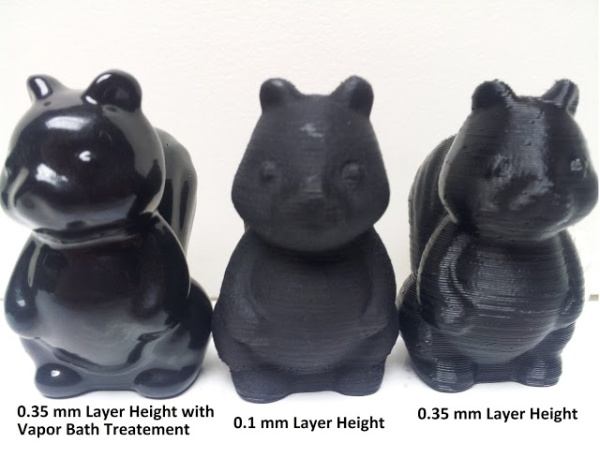##From the printer... Non-post-processed surface smoothness of a print is mainly a function of the Layer height during print: it is smoother if one reduces the height of the steps taken between the layers. A very good FDM machine can achieve down to 0.05 mm layer height, but 0.1 mm is what most hobbyist machines can achieve if well dialed in. SLA printers cure resin in layers down to 25 micron reliably and some can get down to 12.5 micron - a quarter of the best achievable FDM.
Reducing the layer height in FDM comes at the cost of mainly three factors:
- Print time increases roughly antiproportional to the layer height. 0.1 mm is about double the print time of 0.2 mm and so on.
- The prints tensile strength gets reduced by increasing the number of layers increases, creating additional possible weakpoints.
- The thinner the layer, the more susceptible the print is to errors like clogged nozzles or variations of the filament thickness.
SLA printers are not affected by the print strength loss and the errors from clogged nozzles and can print entirely clear material without air inclusions. They are affected by the print time increase though. Usually, SLA prints come out of the vat covered in residual resin and curing them in the proper post-processing method results in this resin smoothing over the surface perfectly.
##Simple Postprocessing... Many prints can easily be post-processed.
###Sanding PLA and ABS can be easily sanded down to somewhat smooth, but you'll need to spend time and muscle grease or go electric. A sander with 300+ grit can help a lot. If you have a rotational body, you could sand the vase on a lathe.
###Putty A plastic putty could be smeared over the stepped surface to smooth it and then sanded smooth. I personally like Valejo plastic putty, as it doesn't shrink, but Tamya putty also is a good alternative, bonding strong.
###Primer-Filler Independent of the base material, using a spray coating can easily fill in the notches and crannies left behind during printing. Printing in 0.15 mm and giving it a short spray coat of primer-filler twice, sanding over rough spots between did a good job of smoothing prints for me.
###Vapor Smoothing If you chose ABS, you could use Acetone vapor to smooth over the surface of a print in almost an instant. This can achieve Super smooth results with tall layer heights, as you practically melt the plastic over, but it comes at the loss of small surface details.
Exposure time is the limiting factor here: the longer the exposure to the acetone vapor, the more the surface is smoothed and the less details remain. Think of exposure time like running the smooth filter in blender once or twice each second.
Similarly, ethylacetate or propylene carbonate could be used for PLA prints, though timing might differ from the well established "a couple of seconds" for acetone vapor. Note that these two chemicals are much more expensive. ###Costs Checking prices, I was quoted about 90 €/l for (chemical grade) Ethyl Acetate and 130 €/l for (chemical grade) Propylene Carbonate via a laboratory supply. Useable Acetone (not chemical grade) comes about 3.70 €/l in home depot. For comparison: chemical-grade Acetone comes with a price tag of about 50 €/l.
Considering that ABS filaments and PLA filaments typically price similarily, ABS+Acetone Vapor is the least costly chemical Vapor smoothing.
